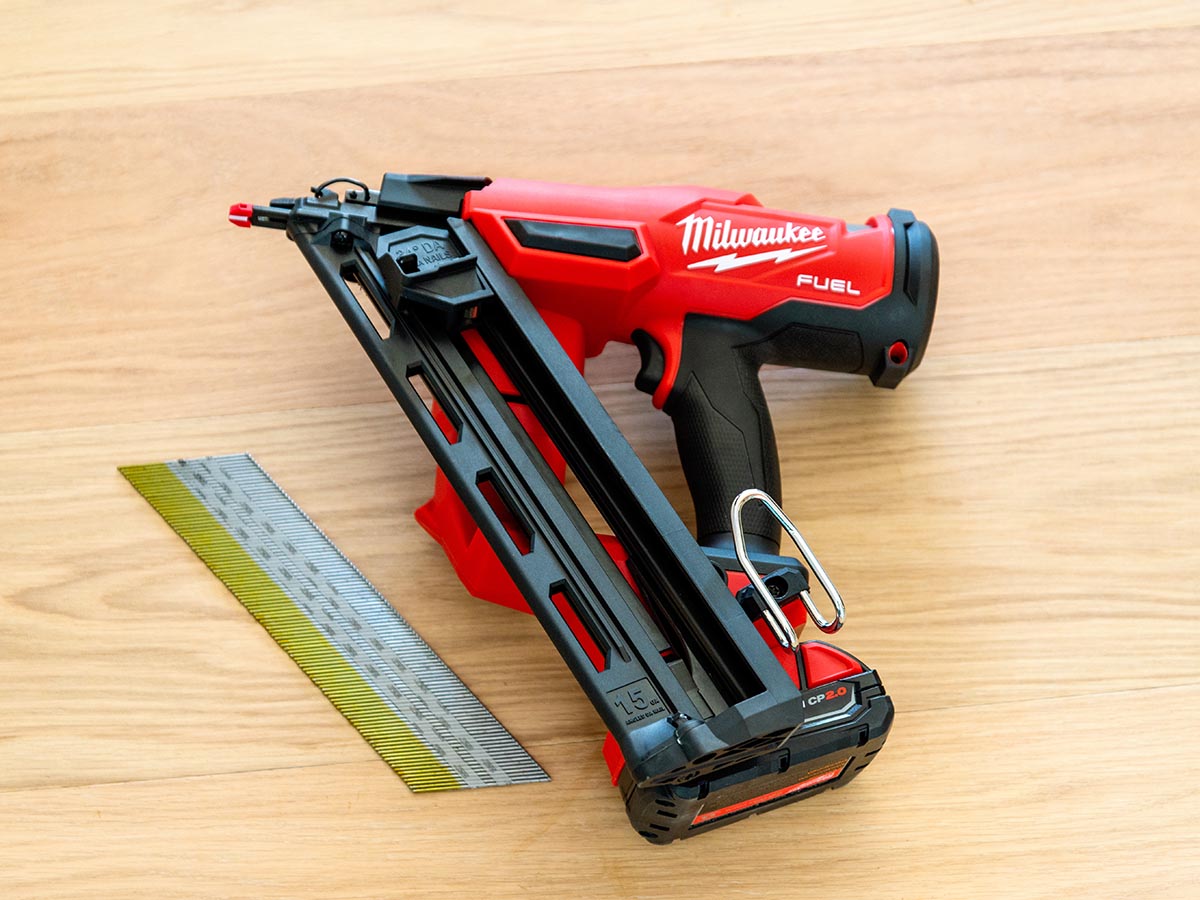We may earn revenue from the products available on this page and participate in affiliate programs. Learn More ›
Whether you’re a professional or a weekend warrior, a good finishing nail gun can boost your productivity and simplify the task at hand. Determining which type, though—pneumatic or cordless,15 or 16 gauge—largely depends on your budget, intended project types, work location, and personal preferences. For those who require the strong nailing performance of a 15-gauge finishing nailer but equally value the convenience of cordless operation, I recently tested Milwaukee’s M18 Fuel 15-gauge finishing nailer, and I recommend checking it out.
Founded in 1924, Milwaukee Tool has been one of the most trusted power tool brands for a hundred years. In recent decades, the company has distinguished itself as an innovator of pro-quality cordless hand tools. I recently tested its 15-gauge cordless finishing nailer alongside some of the most capable competitors on the market, including a 16-gauge DeWalt cordless finish nailer as well as 15-gauge pneumatic finishing nailers from Bostitch, Senco, Makita, and Metabo. The Milwaukee cordless electric nail gun held its own through a 1,000-nail test and earned the Runner-Up award, finishing a close second behind an impressive lightweight pneumatic nailer from Bostitch. In this review, I’ll detail my experience working with the Milwaukee finish nailer, exploring why I think it’s one of the best options for pros and DIYers alike.
Milwaukee M18 Fuel 15GA Finish Nailer: At a Glance
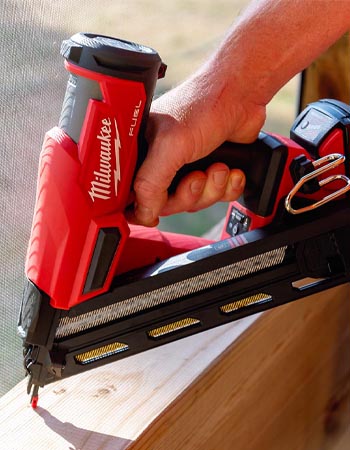
Rating: 8.75/10
SPECS
- Type: Battery
- Gauge: 15
- Weight: 7 pounds 8.4 ounces
- Nail depth: 1.25 to 2.5 inches
PROS
- Powerful, fast, and jam-resistant performance rivals 15-gauge pneumatic finish nailers
- Included 18-volt (V) 2-amp-hour (Ah) battery drives up to 750 nails per charge
- 34-degree angled magazine gives the tool excellent balance and maneuverability
- Zero ramp-up time between squeezing the trigger and the nail actually firing
- Offers both sequential and bump nailing modes for precision or production work
CONS
- Heavy; weighing more than 7.5 pounds, it’s not ideal for overhead work
- One of the more expensive cordless finishing nailers on the market
Get the Milwaukee finish nailer at:
What is the Milwaukee M18 Fuel 15GA Finish Nailer?
It’s tough to find a cordless finish nail gun more capable than the Milwaukee M18 Fuel 15-gauge finish nailer. It delivers the driving depth and holding power needed for heavy-duty nonstructural projects, such as installing window and door casing, baseboards, crown molding, stair treads and risers, and prehung doors. And the kit I tested included everything to get started: the 15-gauge nail gun, an 18V 2Ah battery, a battery charger, and a soft-sided carry case. All I needed to do was add nails.
This nailer comes equipped with all the essential features to finish projects quickly and efficiently. Slightly offset, the 34-degree angled magazine makes it easy to access hard-to-reach corners, and the narrow head with LED lights provides excellent visibility for precise nail placement. Tool-free depth adjustment and jam-clearing mechanisms keep downtime to a minimum. Users can switch between sequential and contact actuation modes with just the press of a button. Additional convenience features include a reversible belt hook and extra storage space for no-mar tips on the magazine. It is compatible with all 15-gauge DA-type collated finish nails. The efficient brushless motor, powered by the included 2Ah battery, can drive up to 750 nails per charge.
I set up four scrap boards to test the nailer: 2-inch and 4-inch-thick pine, and 1½-inch and 3-inch-thick oak. On the face of each test board, I marked a 30-inch S-curve to serve as a nailing guide. Then I followed the lines, driving a nail every ¼ inch. I drove 1¼-inch nails into the 2-inch pine and 1½-inch oak as well as 2½-inch nails into the 4-inch pine and quad-layered oak. I adjusted the nailing depth twice on each board to nail flush and countersink the heads. Afterward, I examined the nail holes for cleanliness, consistency, and accuracy (Did I hit on the line or beside it?). Up to this point, I had only used sequential actuation since I was going for accuracy.
Next, I switched to contact mode to test nailing speed and jamming resistance. Using the same boards and nail sizes, but working freehand instead of following predrawn guidelines, I drove nails in horizontal rows. I adjusted the nail depth to slightly countersink on each board and maintained a rhythm of about two nails per second until the magazine was empty. Afterward, I examined the holes for consistency. I noted any jams or stalls that occurred, as well as how difficult it was to clear the jam.
After performing these tests, I used the nailer to install some baseboard trim and porch handrail caps in order to get a real feel for working comfort. I noted how well it reached into the corners, how easy it was to place nails where I wanted them, and whether it caused any arm strain or hand fatigue.
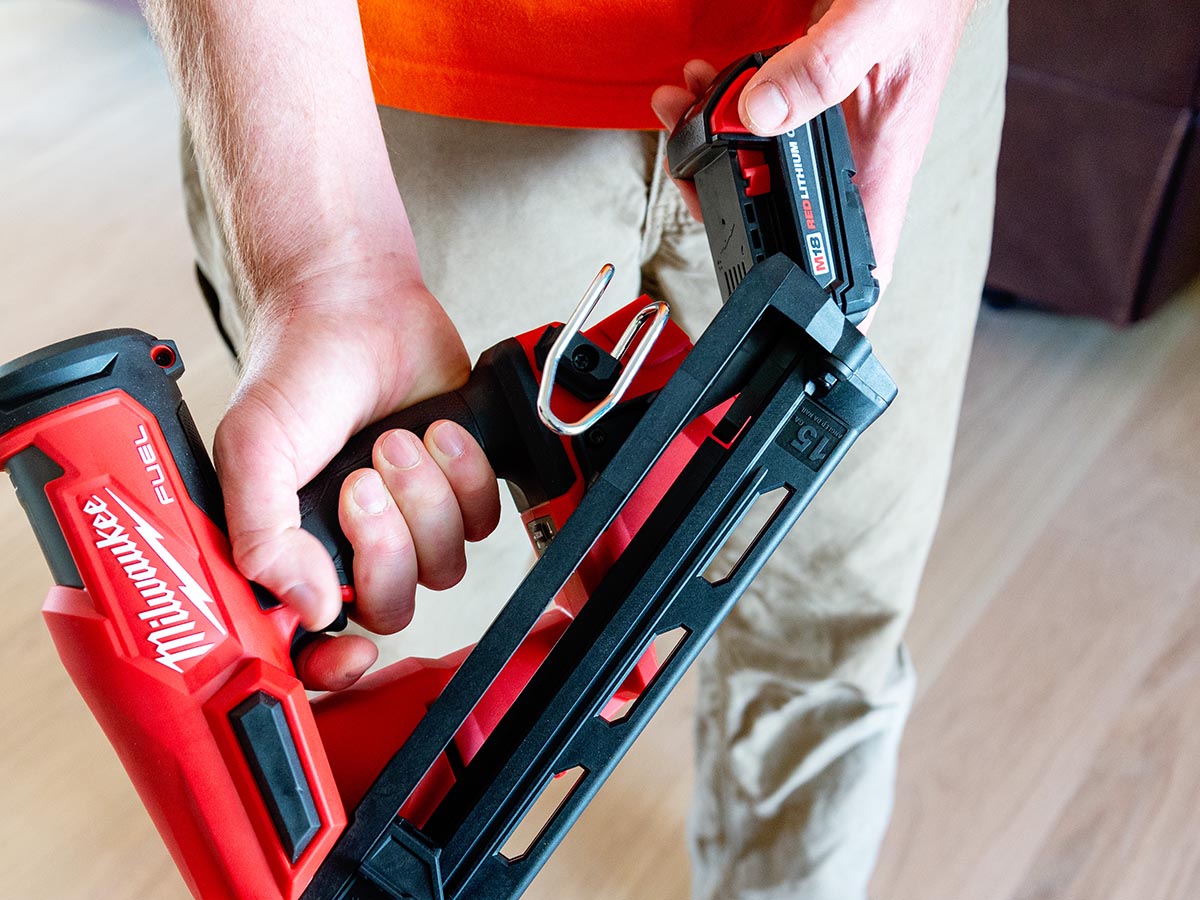
Ease of Use: 4/5
The Milwaukee M18 finish nailer offers numerous features that make it one of the easier nail guns to operate. To get started, the magazine was easy to load, and the nail pusher worked flawlessly to minimize misfires. Also, the mode selector switch made it quick and easy to change between sequential and contact actuation.
The 34-degree angled magazine, slightly offset to the left side of the handle, made it both more compact and more agile than similar nailers with their magazines directly beneath the handle. The center of balance was close to the grip, so it was easy to maneuver in any position, and it fit into tight spaces. It was very jam-resistant—even with long nails rapid-firing into dense hardwood—and on the rare occasions when it did jam, it only took a couple of seconds to clear and get back to work.
The heavy weight of the nailer was the only drawback. This nail gun would be tough to use all day in overhead applications, such as installing crown molding; but for baseboards, or anything at or below chest height, it could be a great option.
Power and Performance: 4.5/5
Through the various tests and projects, I drove 1,000 nails, experiencing zero stalls and one jam. The jam happened in the rapid-firing contact mode with the longer 2.5-inch nails and took about 5 seconds to clear. In short, the Milwaukee M18 finish nailer delivered ample driving power, good depth consistency, clean holes, and excellent rapid-fire performance. Although the gun felt heavy, the angled magazine gave it good balance and maneuverability.
Other 18V and 20V cordless nailers in our original test group came equipped with 1.5Ah or 2Ah batteries, but only DeWalt matched Milwaukee’s nail count per charge. The DeWalt 16-gauge nailer, powered by a 20V 2Ah battery, trumped the competition with just over 800 nails driven per charge, but Milwaukee’s 774 nails per charge was a very impressive performance. The thicker 15-gauge nails require more driving force and offer stronger holding power. Compare this with other cordless nailers in our test group, such as Ryobi’s and Craftsman’s 16-gauge nailers, which each drove about 375 nails per charge.
As for nailing speed, the M18 15-gauge finish nailer drove 400 nails at a rate of two nails per second, jamming only once in the process. That’s pretty good. Milwaukee claims that this gun can fire three nails per second, and it did that for me a couple of times, but I rarely nail that quickly while working. Even better than the rapid rate was the total lack of ramp-up time, even while the gun was in sequential mode. With pneumatic nailers, the ability to pull the trigger and immediately fire a nail is something many of us take for granted, but most battery-powered models lag for at least a split second as the onboard air cylinder pressurizes. I was impressed to see that this nailer performed very much like a pneumatic nail gun.
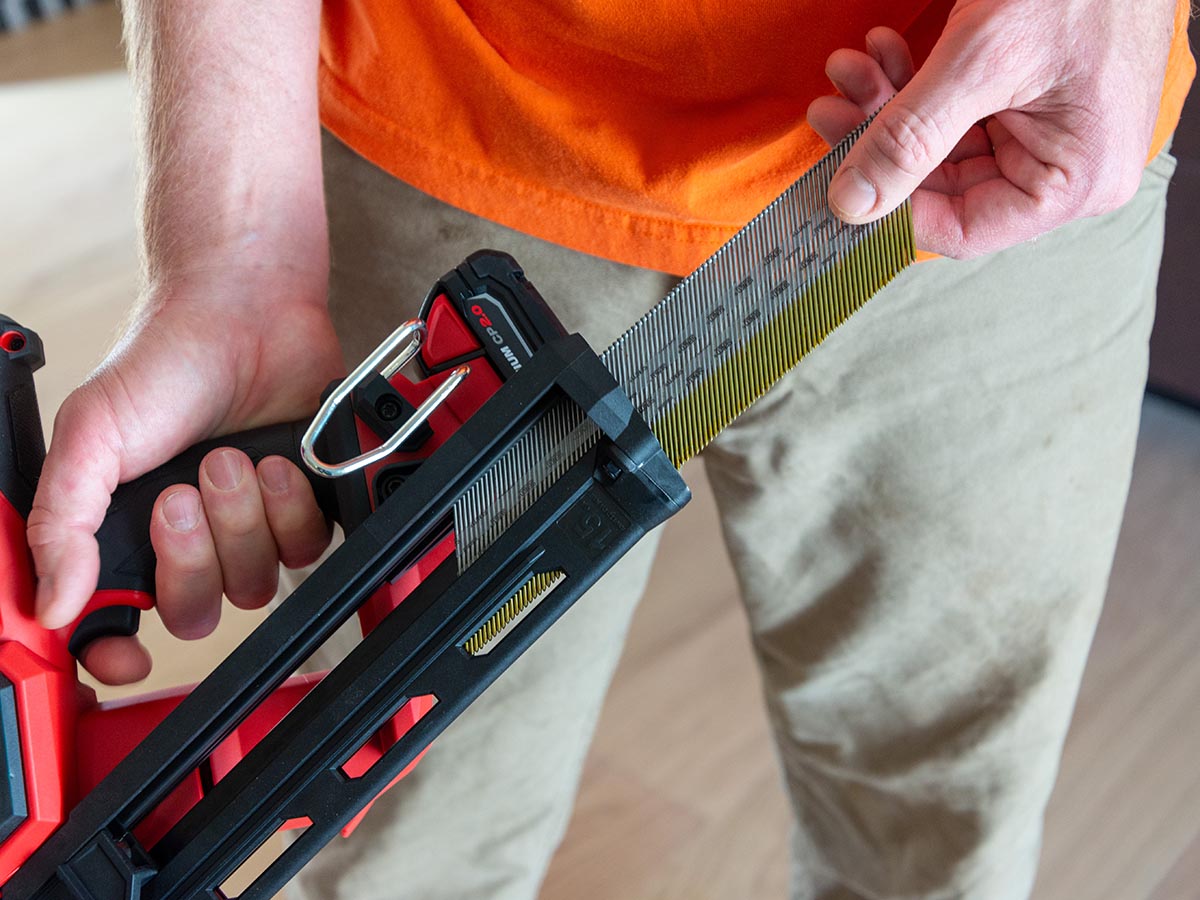
Quality and Durability: 4.5/5
Admittedly, the first 1,000 nails in the life of a pro-quality nail gun hardly tell the whole story, especially when it comes to durability, but I could at least glean some helpful insight. The Milwaukee M18 finish nailer is well constructed, and it features lots of rubber overmolding to provide extra grip and absorb impact in the event of a drop. The nail magazine loaded smoothly, and the pusher never failed to seat the nails fully forward, so I did not experience a single misfire or stall during the test. Jamming can occur for numerous reasons, including excessive pressure by the operator, so I can’t necessarily fault the tool for a single jam in a 1,000-nail test.
Our team has tested numerous other tools from Milwaukee’s M18 Fuel line of battery-powered power tools, including a cordless framing nailer, the M18 Fuel Sawzall, and a battery-powered chainsaw. In the process, a pattern emerged. Equipped with high-power/high-efficiency brushless motors, these tools are specially designed to provide professional-level performance that rivals plug-in electric or gas-powered tools, and they consistently receive high marks for durability, quality, and user satisfaction. Our testers have come to the conclusion that if it comes from the Milwaukee M18 Fuel tool collection, it is likely to be a top performer in its category.
Value: 4.5/5
The kit that I tested sells for around $400, including a battery and charger. Those who already own Milwaukee M18 batteries and chargers can get it as a standalone tool for $329. That is a little pricier than similar 15-gauge cordless finish nailers from Metabo HPT, Senco, DeWalt, and Ryobi. Though it’s not the cheapest tool among the group, it appears to be fairly priced.
With its powerful, dependable nailing ability and long runtime per battery charge, the Milwaukee M18 Fuel 15-gauge finish nailer is a true time saver. It keeps productivity high by eliminating downtime that would otherwise be spent readjusting nail depth, patching ragged nail holes, clearing jams, resetting stalls, and charging batteries. In a professional environment, reduced downtime and higher productivity equal profitability. For DIYers, it means fewer headaches and finding more time for other projects. Even though this tool costs a little more than some of its competitors, the time savings and ease of operation should pay off the difference.
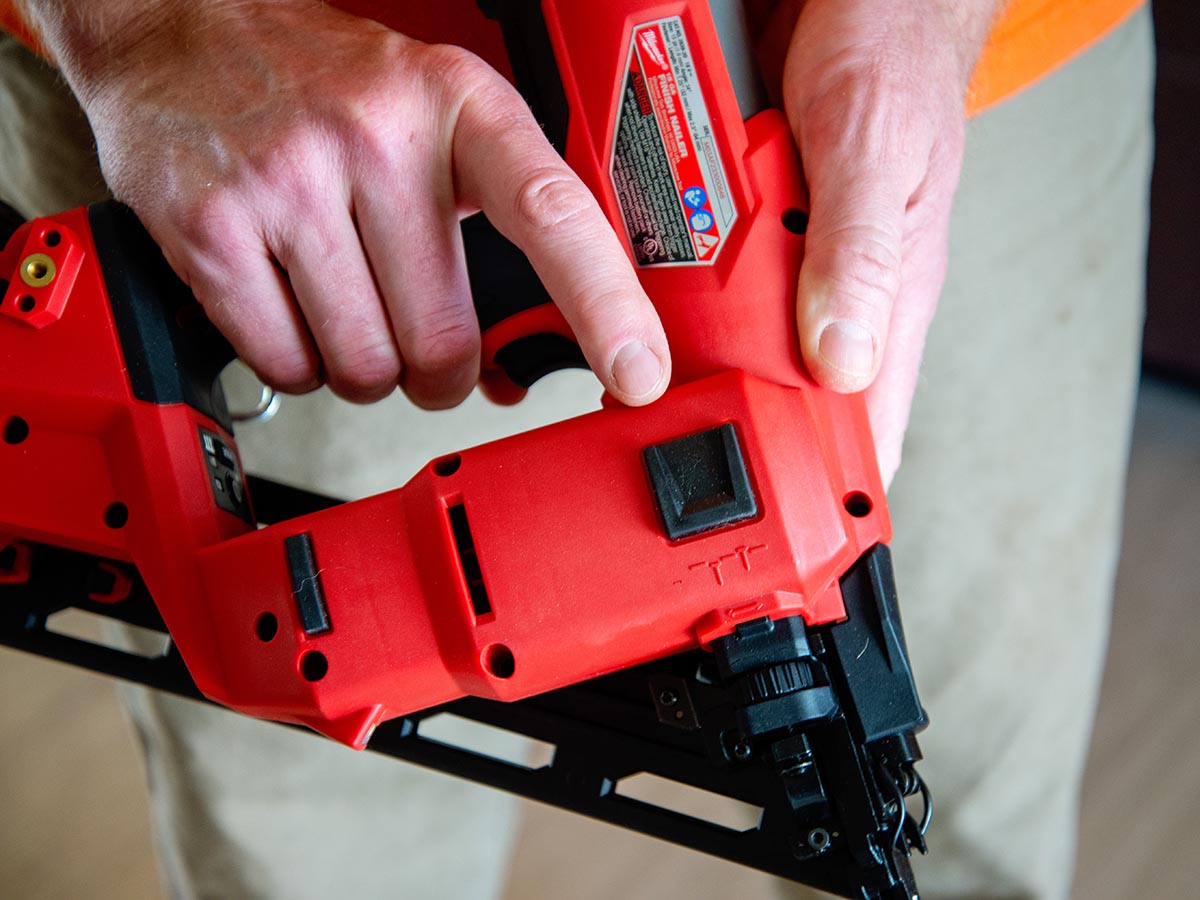
Is the Milwaukee M18 Fuel 15GA finish nailer right for you?
When it comes to heavy-duty nonstructural nailing projects, a 15-gauge finish nailer is the go-to tool. The relatively thick nail shafts and small heads offer the holding power and hide-ability needed for thicker, heavier wood projects. Traditionally, the go-to tool for the job has been a pneumatic nailer, but it has its drawbacks—namely that it comes with the noise of an air compressor and the movement restriction of being tethered to an air hose. The Milwaukee M18 Fuel 15-gauge angled finish nailer offers nailing power and speed comparable to pneumatic nailers but with quiet, free-ranging cordless operation.
This is an excellent nail gun for a broad range of projects. With its 34-degree angled magazine, it has a balanced build that makes it easy to maneuver. It is capable of accessing interior corners with ease. In my tests, it drove short and long nails into both hardwood and softwood with a high degree of accuracy and consistency of depth. The narrow head and LED lights provided excellent visibility. All of the controls were conveniently placed and easy to operate. The only drawback was the weight—the 7.5-pound nailer was a bit heavy for extended use in overhead applications. That said, this is an ideal general-purpose finish nailer thanks to its grab-and-go portability and broad functionality. If it sounds like a good option for your projects, it probably is.
Where to Buy the Milwaukee M18 Fuel 15GA Finish Nailer
Get the Milwaukee finish nailer at:
Meet the Tester
Mark Wolfe is a writer with an extensive background in the green industry and an avid DIYer who lives in a 50-year-old home. When he isn’t writing, he spends his time upgrading, repairing, and replacing anything and everything in his home, yard, and garden. He tests and writes reviews about hand tools, lawn care and home repair products, and outdoor living goods.

